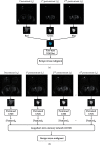Current Status and Future Perspectives of Artificial Intelligence in Magnetic Resonance Breast Imaging
- PMID: 32934610
- PMCID: PMC7474774
- DOI: 10.1155/2020/6805710
Current Status and Future Perspectives of Artificial Intelligence in Magnetic Resonance Breast Imaging
Abstract
Recent advances in artificial intelligence (AI) and deep learning (DL) have impacted many scientific fields including biomedical maging. Magnetic resonance imaging (MRI) is a well-established method in breast imaging with several indications including screening, staging, and therapy monitoring. The rapid development and subsequent implementation of AI into clinical breast MRI has the potential to affect clinical decision-making, guide treatment selection, and improve patient outcomes. The goal of this review is to provide a comprehensive picture of the current status and future perspectives of AI in breast MRI. We will review DL applications and compare them to standard data-driven techniques. We will emphasize the important aspect of developing quantitative imaging biomarkers for precision medicine and the potential of breast MRI and DL in this context. Finally, we will discuss future challenges of DL applications for breast MRI and an AI-augmented clinical decision strategy.
Copyright © 2020 Anke Meyer-Bäse et al.
Conflict of interest statement
The authors declare that they have no conflicts of interest.
Figures






References
-
- National Research Council. Toward Precision Medicine: Building a Knowledge Network for Biomedical Research and a New Taxonomy of Disease. Washington, DC, USA: National Academies Press; 2011. - PubMed
-
- Mitchell T. Machine Learning. New York, NY, USA: McGraw-Hill; 1997.
Publication types
MeSH terms
Grants and funding
LinkOut - more resources
Full Text Sources
Medical
